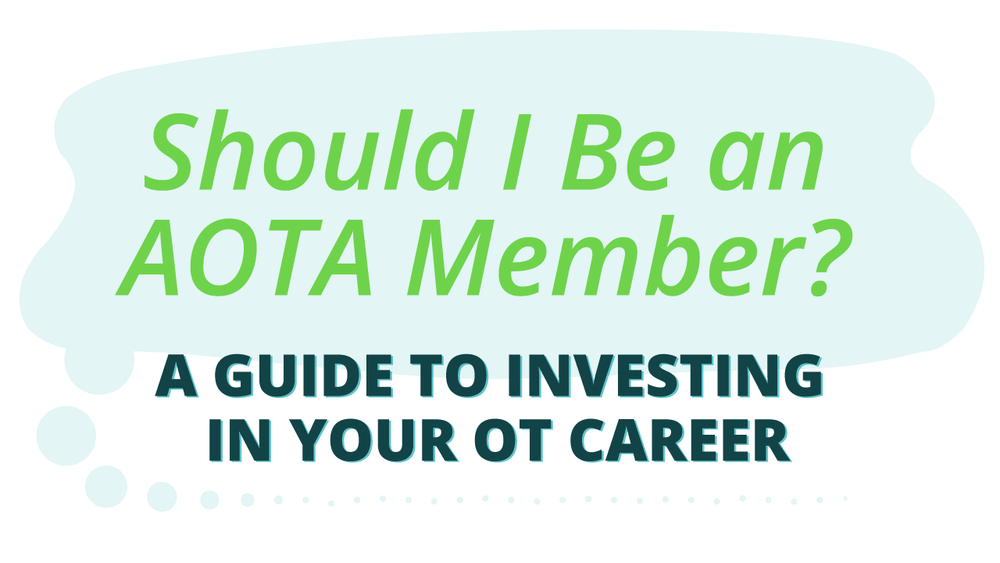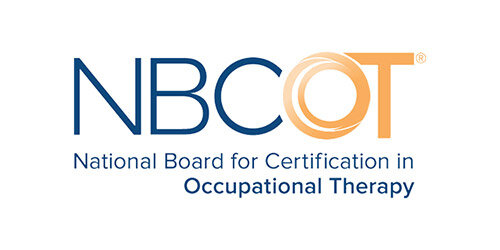
The number one question that my OT friends ask me is whether or not they should be AOTA members.
Honestly, I never feel like I can help them answer this question without pulling back and taking a look at the big picture.
And that means considering how much––and in which ways––they want to invest in their OT careers.
There are *so* many options out there for investing in your career.
Those costs can add up, and there’s no shame in wanting to invest your time and money wisely.
Nobody can do it all (or afford it all!), so I’ve created this guide to help you understand the different options you have to invest in your career and the occupational therapy profession.
I have my own opinions on where I have chosen to invest, but my goal in this article is not to sway you, but rather create an informative list of your options.
Here’s what we’ll cover in this article:
- What are the unavoidable expenses of being an OT (licensure, CEUs)?
- Should I be an AOTA member?
- Should I be an NBCOT member?
- Is it worth joining my state OT organization?
- What are the benefits to investing in additional research platforms?
- Is an additional certification worth it?
Ok, let’s dive in.

The unavoidable expenses
If you want to legally practice as an OT, as mentioned above, you cannot avoid the recurring costs of your license renewal and CEU requirements. Here’s a bit of explanation around the costs.
Occupational therapy license
(Cost: $20-$279)
Please. Please. Please. Do not let your OT license lapse. Ever.
You spent tens of thousands of dollars to obtain your degree. It is absolutely worth the $20 (Illinois) to $279 (Hawaii) to keep your license active.
Many of us take a hiatus from treating patients to raise our kids, while others follow non-traditional OT career paths. Some of us even pursue new careers or leave the workforce altogether—but it’s still a very good idea to keep your OT license active.
That’s why I implore you to consider license renewal fees as unavoidable costs.
Most licenses are good for one or two years (with New York being the only state whose license is good for three years), and this is usually the same amount of time you have to fulfill the continuing education requirements.
Continuing education
(Cost: $99-thousands)
We’ve established you need a license to practice and, in order to keep your license, you also need continuing education units (CEUs) each year, which will generally run you anywhere from around $99 to thousands of dollars.
(The exception to this rule is that three states—Hawaii, Massachusetts, and New Jersey—don’t require CEUs to maintain your license.)
There are free options, paid options, in-person options, and online options.
Obviously, if you’re looking at this from a financial standpoint, the free options are most appealing, but those might not give you the best clinical and professional growth.
Here’s a list of a few CEU solutions to get you started:
- The OT Potential Club – $79/year
- MedBridge Education – $200/year with my promo code (I am an affiliate.)
- Summit Education – $299/year
If you’d like to grow your career while you take CEUs, you can take courses that would build toward an additional OT certification.
Certification costs vary tremendously, from around $500 for the coursework and exam required for a Certified Aging in Place Specialist (CAPS) certification to $3000 to become an Certified Lymphedema Therapist (CLT). (We will cover this more in depth below.)
Given the fact that you can literally spend under $100 or upwards of $3000 on CEUs, you’ll probably want to base that decision partly on how much you want to invest in several other optional expenses of being an OT.
And that brings us to…
The optional expenses
Ok. Now that you’ve made peace with the roughly $200/year minimum that you’ll spend to be an occupational therapist, you can start thinking about the myriad of other ways to invest your money.
As I said earlier, how you do so really depends on who you are and what you want!
American Occupational Therapy Association (AOTA)
(Cost: $225/year)

The American Occupational Therapy Association (AOTA) is our professional organization. Its aim is to improve the quality of OT, and represent the interests of OT professionals and students in the US.
Annual dues are $225/year (OT) and $131/year (OTA), and you can pay monthly, which amortizes the costs.
Roughly 60,000 of the approximately 213,000 occupational therapy professionals are members of AOTA, so you’re in good company whether you decide to make the investment or not!
Is AOTA worth it?
I’ve tried to break down the benefits of membership to help you make this decision, because the answer is, “It really depends on you and your priorities!”
With your membership, here’s what you’ll get:
- You’ll get a free AJOT (American Journal of Occupational Therapy) and OT Practice subscription while you’re an AOTA member, as well as access to all sorts of additional OT-specific mailers, newsletters, and reading materials.
- You’ll have 35% of your dues go to lobbying efforts on behalf of the OT profession.
- You’ll save up to 30% on the cost of registering for the national convention. The actual price (and savings) information is not available on their website until registration opens in December.
- You’ll save $10 on articles with tests at the end that provide one contact hour each (paying $24.95 instead of $34.95), and you’ll enjoy savings on other coursework and texts sold through AOTA.
- You’ll get several other random discounts on things like life and supplemental disability insurance.
- You’ll get access to the massive amount of members-only content on their website.
- You’ll get the warm fuzzies of knowing you’re a member of your professional organization, for what that’s worth!
The affiliates of the AOTA
If the benefits are looking appealing, there are a couple more factors to consider.
The AOTA has multiple branches that are set up as their own non-profits. If one of these aligns with your investing passion, you may be able to give directly to that organization. Others require that you join the AOTA to participate.
(Author’s note: We did our best to research and summarize these. If I got something wrong, please correct me in the comments!)
Here is a breakdown of AOTA’s finances and some more information on how these branches are supported by the AOTA.
If you are passionate about national advocacy…
You must belong to the AOTA if you desire to give to the American Occupational Therapy Political Action Committee, above and beyond the 35% designated by your AOTA membership. This organization is technically separate from the AOTA, but the two are closely associated.
If you are passionate about advancing research…
The American Occupational Therapy Foundation (AOTF) is a non-profit that gives scholarships and grants for research. This organization is also closely affiliated with the AOTA, but you can donate to the cause without being a member.
If you want to be a member of the World Federation of Occupational Therapists (WFOT)…
You must be a member of the AOTA (or your country’s national association) if you want to be a member of the World Federation of Occupational Therapists.
The cost for AOTA members to join is:
- Student – $27
- OTA – $30
- OT – $32
- Associate – $60
If you are in it for American Journal of Occupational Therapy (AJOT)…
Don’t throw down your credit card quite yet. In fact, if you’re a NBCOT certificant, you get a free subscription to ProQuest, which in turn gives you access to recent issues of AJOT.
So, if you’d be joining AOTA for the journal, that might not be necessary if you’re an NBCOT certificant.
If you’re an OT super nerd and NEED access to the Wilma West Library…
Yup. I’ve paid for this access.
The Wilma West Library houses historical documents related to OT, and is accessed through OT Search.
- Individual Members: $75.00 – per year
- Individual Student Members: $45.00 – per year
- Individual Non-Members: $200.00 – per year
If you just want more people to know about OT…
The Fund to Promote Awareness of Occupational Therapy was commissioned by the AOTA, but again is a separate organization. You can donate directly here.
At the end of the day, only you can decide whether you want to join AOTA and its affiliates.
There are compelling reasons to join, and equally compelling reasons not to join. If you want access to discounts on courses, access to AJOT and other publications, and support the political initiatives that that AOTA espouses, it’s a pretty small financial investment.
That said, everyone’s financial situation is different, and it’s totally up to you whether you wish to join.
The National Board for Certification in Occupational Therapy (NBCOT)
(Cost: $65 every three years)

The NBCOT is a private non-profit credentialing organization that provides certifications for the OT profession. Its mission and vision are respectable––it’s all about advancing evidence-based care in the occupational therapy world.
And it’s not a huge financial investment, at $65 for three years.
However, the costs can add up when you obtain your required 36 units of professional development required during that time.
And tracking down those professional development opportunities and then documenting them can be, well, a hassle.
Should I be an NBCOT member?
The main reason people opt to join NBCOT is that it gives you that “R” after your license.
It feels nice to sign “OTR.”
Similarly, the NBCOT is the organization that takes you from OTA to COTA.
Professionally, that extra letter looks good. Some employers do wish to hire OTs and OTAs who are OTRs and COTAs because it signifies having met the educational, fieldwork, and exam requirements.
It’s like having a personal brand saying “I go above and beyond.”
You can also look at this certification as a complement to licensure. Where some states don’t require any CEUs for license renewal, NBCOT proudly tries to level the playing field by ensuring that all OTs across the nation who are certified have a baseline continued competency fulfilled.
Something many folks don’t realize is that with NBCOT certification, you get a free subscription to ProQuest, which gives you an automatic subscription to recent issues of AJOT.
So if you were going to join AOTA solely for the AJOT access, this might make you reconsider.
A few extra benefits include the Navigator Competency Assessment Platform, which you can use to show your areas of strength and weakness in your clinical care. It’s a really cool, humbling system, and in more than half of the states, you can use units obtained from the NBCOT Navigator to fulfill your CEU credits.
As with the AOTA, it’s really up to you and your career goals whether NBCOT is worth it.
State professional organizations
(Cost: $70/year, if you are blessed to be an OT in Nebraska!)

OTs have the luxury of deciding whether to belong to state organizations, independent of our participation in our national organizations.
(PTs, for example, are required to join a state professional organization when they decide to invest in an American Physical Therapy Association membership.)
Each association provides a voice for OT, and is involved in both state and national legislation.
The links and contact information for each association can be found here. I won’t go through the fees for each state, but here in Nebraska, an OT will pay $70 for an annual membership, and an OTA will pay $50.
Should I belong to my state OT organization?
You might be tired of hearing me say, “It depends,” but it really does depend.
As I mentioned earlier, advocacy can be its own career path, and if you’re interested in that career path, a state membership is invaluable.
You’ll have a high touch point with other professionals and opportunities to take on leadership roles much more easily than you would on a national level.
A state membership provides a career path, networking opportunities, special interest group meetings, con-ed, and employment opportunities, as well as up-to-date info regarding clinical and regulatory developments.
If you’re a new grad looking for jobs, or you’re a clinic owner or compliance specialist, joining your state organization will be worth gold! But for others, it might not be worth the cost.
Should I obtain another research subscription?
(Up-to-Date subscription: $519/year)
As I mentioned above, if you’re an AOTA member or NBCOT member, you’ll have access to AJOT. If you’re an NBCOT member, you’ll also have access to an extremely powerful research platform, ProQuest. ProQuest provides full-length, multi-disciplinary articles on a number of topics.
In my opinion, you can use a combination of Google Scholar and ProQuest to kickstart your research efforts and you’ll get pretty far!
Google Scholar is free to use (but has lots of pseudoscience, so beware!), and ProQuest purchased on its own will cost $299.95 ($199.95 for the first year). See why I’m so excited by the free access with my NBCOT certification??
All things considered, if you’re working in research, or give research-based presentations on a regular basis, you might want to purchase additional research access.
I go into the details more thoroughly in the article OT Research Options Made Easy.
Should I pursue an additional certification?
You’ve probably heard of all sorts of additional training and certification options, including NDT, Neuro-IFRAH, LSVT Big, CAPS, and more.
Many certifications cost quite a bit of money to obtain in the first place, then additional funds to maintain the cert.
My recommendation is that you check with your employer to see whether you’ll receive reimbursement for training or certification, as well as whether certification will increase your pay grade or somehow impact your growth opportunities.
Unfortunately, in today’s healthcare climate, many employers reduce all of our hard work and education to billable units, and if you work for that type of employer, you might find that all that hard work and training is useful and valuable to your patients, but you have to use all of your PTO and break the bank to obtain it.
If that’s the case, you can consider asking a certified coworker to mentor you and teach you some of the techniques, rather than invest the time and money on the certification.
If you’re lucky enough to work for an employer who provides growth opportunities and advancement, or pay increases, when you obtain additional certifications, it can definitely be worth it to both your patients and to you.
Another thing to keep in mind is that some certifications cost much, much less to obtain than others.
For example, a Certified Aging in Place Specialist (CAPS) certification can be obtained online for around $500, while an NDT/Bobath certification can cost thousands, plus on-site training (with associated hotel and travel fees).
When you consider that some certifications cost less time and money than attending a conference, it does come down to:
- Which certifications will help you most in the clinic
- How much you want that additional training from a clinical and professional perspective
- Whether you’re footing the bill or having an employer pay for it
- Many other considerations that make your situation unique
For an overview of OT certifications, check out my post “Where to Go with an OT Degree.”
Breaking down all the costs
We OTs tend to like to be involved, but the majority of us also live on budgets, so we have to choose how––and where––we invest our time and money in our careers and our profession.
If you wanted to do everything possible, you could easily spend upwards of $4000/year. That’s assuming you’d enroll in the most expensive continuing ed courses, travel-cross country to take them, and pay for all the travel, coursework, and hotels yourself.
If you wanted to do the bare minimum, though, you can probably get away with spending as little as $200-300/year to simply maintain your license and take free or cheap online con-ed.
Assuming you want to do something in the middle, like most of us, it’s time to pick and choose, and hopefully this article has helped you do that!

How do you choose to invest in your careers, and what are your reasons? Let us know in the comments!
Disclaimer: Policies and prices are always changing, and this section was written accurately to the best of my knowledge at its time of publication. I did have several other professionals weigh in to ensure accuracy, but if you see any errors or inconsistencies, please let me know in the comments, and I will update this article accordingly!


3 replies on “Should I Be an AOTA Member?”
Every OT should at least be a member of AOTA and their state OT organization because both of these groups advocate for our profession to maintain our scope of practice.
Excellent blog. I really like what you’re stating and the way in which you say it. I can’t wait to read much more from you.
AOTA members also receive access to the Australian Occupational Therapy Journal, British Journal of Occupational Therapy, Canadian Journal of Occupational Therapy, and discounted access to OTJR: Occupation, Participation, and Health.